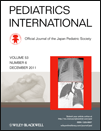Variations in early gross motor milestones and in the age of walking in Japanese children
Abstract
Background: Gross motor development is usually assessed in terms of age of achievement of motor milestones. Although there is generally an impression of faster development if the milestones are achieved at younger ages, no longitudinal studies have been done on the associations between the milestones, especially in Japan. As a part of the Japan Children's Study, the purpose of the present study was to determine whether the achievement of gross motor milestones in infancy is related with the age of walking.
Methods: This was a prospective cohort study of 290 healthy and term infants born in a district of Osaka City, Japan. Three milestones (rolling over, sitting, and crawling) were observed in the laboratory for infants aged at 4 and 9 months by a pediatrician and a developmental psychologist, and the age of walking was confirmed in questionnaires filled in by the parents at 18 and 27 months.
Results: Children who could roll over at 4 months, and sit and crawl at 9 months, walked earlier than children who could not roll over, sit and crawl, respectively. With regard to crawling, children who were creeping had a 1 month delay in walking, and those who could not move forward had a 2 month delay compared to typical crawlers. On multiple regression analysis these three milestones were positively associated with walking: rolling over (β= 0.567), sitting (β= 1.973) and crawling (β= 1.473).
Conclusion: The age and the patterns of sitting, crawling and rolling over were all related to the age of independent walking among Japanese infants. Consideration of milestone definition and variations is essential in medical check-up.




